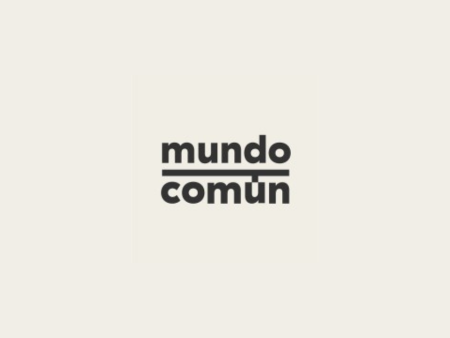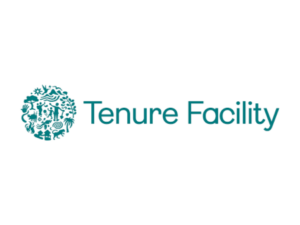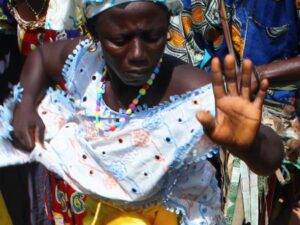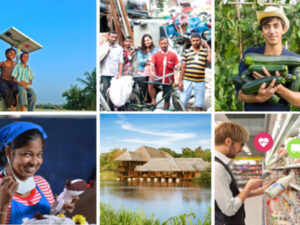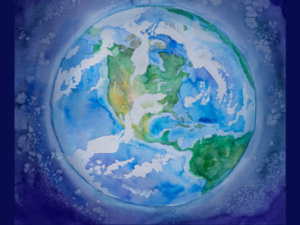mundo común designs collaborative stories and spaces in mobile formats of refuge and inspiration, activating the collective wisdom and creative agency of beings and territories, helping to restore, through care, the conditions for life to thrive abundantly for all.
Isabel Cavelier and Lina Herrera spoke with Ambika Samarthya-Howard on July 11, 2025. Click here to read the full conversation with insights highlighted.
Ambika Samarthya-Howard: Can you start by introducing yourselves and your organization?
Isabel Cavelier: My name is Isabel Cavelier, and I’m the Founder and Director of mundo común.
Lina Herrera: I’m Lina Herrera, and I am the Co-Director of mundo común.
Isabel Cavelier: Anything related to the climate crisis is related to our work in a way, but we don’t have a downstream of work on one specific area, like land tenure, or Indigenous rights. Our work is upstream, so it is applicable and relevant for those areas, but it is not a downstream solution specifically dedicated to any one issue.
Ambika Samarthya-Howard: What is your upstream approach, and what do you mean when you say it’s applicable to the downstream?
Isabel Cavelier: The reason I say our work is upstream is because when we started mundo común, our big question was, How can we reduce 10 million tons of CO2 equivalent emissions in 10 years with only $3 million? Those $3 were our Climate Breakthrough Award. It was a huge task. When we dived into thinking about a breakthrough strategy to achieve this, we realized that reducing 10 million tons of CO2 equivalent in 10 years was going to be useless if we didn’t go into the root of the climate problem. It was not enough to just think about a symptom, like emissions.
We could reduce some emissions; other emissions would replace them if we didn’t understand what was at the root of the way our civilizations are organized, of what causes us to end up in an economy that produces high emissions, or pollutes our ecosystems. That’s what I mean by upstream. We went upstream in terms of seeking to discover the root of this problem, rather than trying to focus on a particular solution.
That’s super important, and many people are doing that kind of specific, solutions-based work, but we wanted to tackle the root of the problem. That’s why our first approach was trying to understand complex systems change and the levers that affect systems at the deepest level. We engaged back in the day with the work of the Berkana Institute and Donella Meadows, the mother of systems theory.
We understood and we were very much in resonance with her work and the idea that we need to work at the level of mental models and paradigm shifts, and deep, cultural and behavioral change. Our problem when we think climate crisis is actually a deeper human identity crisis. It’s not merely a crisis of economic output.
It’s a deeper spiritual crisis. It’s how we understand our role as humans in this world, it’s how we relate as living beings to the living world, the living cosmos. The work we were observing of people in the broader climate community was not that at all, we realized. We had been working on climate for a decade and a half, and the conclusion we came to through self-observation was that we are like hamsters in a hamster wheel, racing to produce solutions, technical solutions, and complicated technocratic policy solutions, that are important, but that are never going to be enough. The only thing we are doing as we design these solutions is depleting ourselves and repeating the paradigms that created the crisis in the first place. By not observing ourselves, we are deepening the crisis.
That’s how our work is upstream. We decided that the first thing we need to do is shift the paradigm of the climate community mindset. This is a very large, powerful community, but it’s not successful. We have a very successful narrative, as in net-zero, bang, five years, it’s around the globe, but is it really happening? In reality, how many people are achieving these goals? Emissions are not going down. They’re going up.
Discursively, the climate community is powerful. It’s around the world, it’s in every ecosystem, in every government, in every big company. It’s from the grassroots all the way up to the highest levels of government. It’s well-connected. It has citizen support. It is very deeply ingrained in science. It has all the tools in the world. It’s very strange, then,that this community has been so poor in creating the outcomes it needs. We believe the reason why is that this community has been overlooking the deeper paradigm shift that we need.
Even though we are often criticized for preaching to the choir by working with the climate community, our theory is that if we unleash the power of this community by helping them to really understand the root cause of this problem, and to start working from a place of redesigning our human identity and reweaving our relationship with the living earth and living cosmos, the solutions that we design will stop being partial solutions, or answers to little problems. It will unleash a bigger paradigm shift in our societies.
We need to start with what we call the relic forest, because in ecosystem regeneration, ecosystems regenerate from relics. They regenerate from the standing forest, from the standing reef, from the place that is still alive. The climate community is a relic forest of the human mind, of the human psyche. It’s the people who want to make this transition happen. First, we need to nourish this community, keep it safe and healthy, and second, we need to understand the problem properly and design from that place of understanding. mundo común’s work combines the contexts around why we are working upstream. We are working with people who are involved with Indigenous and land rights, with women, with youth, with art, design, communications, journalism, you name it. We are combining two streams of work that, after working with Donella Meadows and other authors, we believe are the key to shifting deeper mental models.
The first step is to shift the story, retell the story, retell all stories, and tell new stories about the problem, what we can do, and how our identity can shift in the world. The second step is to live the story. Experience what it means to relate to the world differently because it’s not enough to tell a story. You need to have a memory in your body of what it means to relate from a place of care rather than a place of extraction. What does it mean in your body to collaborate with modern human beings and other entities, and not just to care for them, as in saving the world or saving nature, but to relate to nature as a partner in this quest for a new earth? Narrative and experience are constantly intertwined. They are the basis for shifting the deeper mental model and inspiring behavior and action based on a human identity that not only understands itself mentally, but embodies its role in a relational way, a way based on care, that deeply understands our interdependence.
We are inevitably, inextricably interdependent on one another. We know this, but our work makes us live it, makes us feel it, makes us dance it, makes us eat it.
Ambika Samarthya-Howard: How do you know you’ve succeeded at doing that? Can you provide some examples of success, or examples of how you’ve been able to break through the noise around climate messaging?
Isabel Cavelier: I believe that climate folks have fallen into the trap of a binary, of utopian and apocalyptic narratives, and they are both equally perverse. We try to convince by picturing apocalypse and bringing about fear, anger, discontent, and outrage. That one is very overused, hence generating a numbing effect in audiences.
Then there’s the utopianism techno-fix, and the overly solutionistic narratives where you only focus on things that are great and a new, utopian world that is already happening. That is equally dangerous because it also has a numbing effect, although different, whereby it’s all better because you focus on the positive. It’s numbing us to the difficulties and losses that are very real and are also happening alongside the regeneration and sustainability.
It’s a polarity that is very tricky, and it is very human for us to go to either one or the other because we want to grasp something that feels secure. Either the world is ending, or the world is being saved.
In terms of breaking this noise, it’s hard to hold the tension of the thin line in between these two. It’s not one or the other, it’s both. Yes, the world as we know it is ending, and it’s going to be painful. It’s happening already. All that is true, and all the other things are true. The world is also regenerating. We are birthing a new world right now.
The human psyche has trouble holding this idea of both. There’s a philosopher I really like, Timothy Morton, who wrote Dark Ecology. He says that our big problem in modernity is that we are used to the law of no contradictions, to a reality that is not contradictory. It’s either you, or it’s not you, but it can’t be you and not you at the same time. A parking lot is a parking lot. It is not a forest at the same time. Morton breaks that paradigm and says, Reality is contradictory all the time. I am me, and I am not me at the same time. For human minds, this is very hard to grasp.
Breaking the noise is putting out narratives that maintain the tension between these two polarities and learning to listen to it without falling into the anxiety of not knowing. It’s tough. We’ve tried to avoid going into these traps of apocalypticism or utopianism. I think it has been a beautiful exercise because when we get feedback, people feel it’s more real. It’s more real when you are able to account for that contradictory reality of not denying one or the other, and understand that we are in a very muddy moment of transition.
That’s how we are trying to orient the content. The format is also essential because form is content, and content is determined by its form. We’ve been innovating much more with form and the container of the narrative. One of the things that’s brought us to Skoll this year is that we’ve created a format whereby we share stories that are embodied. We call it somatic storytelling.
Lina Herrera: We combine somatic work with storytelling practice. In this case, we created a more-than-human entity by using three voices: the somatic guidance that I do, the storytelling that Isabel does, and a third voice that, in this case, is water. We tell the story of water on earth but through our bodies. We try to invoke the intelligences of the body, beyond just the rational. We seed an intention and ideas in the deepest memories of the body by moving the waters inside it. We invite people to participate in the story with their body.
This one is two hours long, and it starts with you moving your inner waters while you listen to the story of water on earth, and why we are more liquid bodies than solid bodies, how our skin is porous, and how we are interconnected. In the end, it’s more like a feeling experience of interdependence rather than trying to understand the concept intellectually.
We want to develop similar formats with other entities.
Ambika Samarthya-Howard: Did you do this at the forum?
Isabel Cavelier: Yes. It is a good example of success. There were so many beautiful testimonies, but at the end of one of these sessions in Oxford, one of them was very touching. A man in his 60s from the US, a very White, very baby boomer kind of person, was almost crying. He said, I really felt non-separation. I feel for the first time that I’m not separated. For us, this tiny sentence is success.
Lina Herrera: We can describe our work as designing experiences for the climate community, but we can also describe it as designing experiential narratives. They are the same thing. We are trying to break the boundary between body and mind by understanding that we are whole. We try to hack our brains during this two hour session, but we also have a week-long retreat, a ten-month program, an hour-long conversation. We are always trying to engage people to be part of a mycelium of change in the sense of replacing the unconscious practices that reproduce the old paradigm and making space for new practices that can shift the relationality around care and interdependence.
Ambika Samarthya-Howard: Are you saying that, if people experience the somatic body-mind approach and engage in interreflection of interdependency and interconnectedness, they’ll be more responsible or accountable for the climate? What’s the theory of change of getting from that experience to the work?
Lina Herrera: One of the main places we have found the impact is people wanting to be part of the climate community. There are a lot of people who are so tired and depressed that they just want to drop out [of society]. The most evident impact is when people decide to come back and participate, reengage with being a change agent in the community. Every format we design is based on ecological phenomena that inspire our narrative. We not only collaborate with the modern human in a symbolic way, but we try to bring their wisdom to our formats.
We created a format called Refugia. Refugias are the little pockets of seeds that remain after a cataclysm. After catastrophes, fires, floods, volcanic explosions. We’re creating our own refugias in little pockets of the DNA of the ecosystem that help regenerate it in an interconnected way. We are designing week-long refugia retreats that we want to spread all around the world, where we invite activists and land defenders to not only recover their sense of agency, but restore their mind and body so they can spread these new practices throughout their communities.
There was one woman, Enilda, who was a victim of conflict and very harsh violence in Colombia. She’s a well-known ecological activist for peace, and we invited her to our refugia. When she came, she realized, My land is a refugia. I’m going to be a refugia. I’m going to bring other people to do this. She recreated her land in a regenerative tourism initiative, and she is now using her resources to recreate a refugia with the women she is leading in the initiative. It’s the seed spreading out. People taking the concept of refugia, of being refugia themselves, and bringing it into their own communities, into their own context.
What we do in the retreats is provide little practices to help people embody a new story. We are also designing a handbook and a toolkit to help people reproduce these practices within their contexts.
Cuerpo Enjambre is another good example. It is a 10-month program of artists, creators, and scientists that brings collaboration between science and art around the possibility of creating embodied narratives of change. We went to the Amazon for one week, at the mid-point of a program of 12 conferences and online talks with experts around systemic change, and did this at a small scale. It’s called the Swarm Conference.
Isabel Cavelier: We were inspired by bees. We went and studied bees because bees are good at creating new homes, and in this transition of the world, we’re also creating a new home. We’re creating the world again together. If bees are good for that, let’s understand how they do it, and try to do it ourselves. We call it Body Swarm, Cuerpo Enjambre, because we ask, How can we do that with our bodies?
We went to the Amazon with these artists, creatives, and scientists and had these conferences, and we also created swarms. We did the waggle dance. We had a methodology based on the way bees do it, and we did it ourselves, creating collaboration containers. They collaborate in swarms. They waggle dance to figure out what to do. Each of those swarms has chosen one or more human beings to collaborate with to create a new, embodied narrative.
Ambika Samarthya-Howard: Bringing it back to the basics, how did you choose who was going to be there? How did you pick the agenda?
Lina Herrera: We understand that climate change is a hyper object that is hard to grasp, but what we try to do in the end, is create the faith that we can all participate in the transformation. I would say that we are world makers. We designed a website where we did an open call, and we also invited specific people directly, so it was a hybrid.
Isabel Cavelier: We had a whole process. We had 70 applications for about 12 spots.
Lina Herrera: We are trying to see who is paying attention to these narratives. Who are the ones willing to take the risk? It’s very challenging.
Another marker of success that is important to me is seeing how, during the phase of creation, when many people feel like dropping out, they are able to go through the difficulties and reengage with the challenge in an even deeper, more intimate way. We create that affection.
One of the challenges we have is not only using the rational way of speaking or communicating, but inviting other ways of perception to help us comprehend what is required to participate in this transformation. That is challenging because sometimes, people think they don’t understand. It’s an uncomfortable place to be at times, but we’re trying to explore other narratives that can help us appeal to other facets of ourselves during this transformation.
Ambika Samarthya-Howard: When you studied bees, what did you see that you tried to replicate in creating these connections and affections?
Isabel Cavelier: We can show you a video because we made a little film. There were 25 artists and researchers, and the session was a week long, although they’re all still working together.
We led, but the person appearing in the video was also a leader. He is the shaman of the town next to the place where we were staying.
Ambika Samarthya-Howard: What I’m noticing as I watch this video is that everyone is involved in relating to the forest and their environment in a very different and personal way. Some people are taking photos, some people are drawing, some people are touching, some people are looking, some people are listening. There’s a huge level of intimacy and personalization. Not everyone’s doing the same thing as part of this collaborative.
Isabel Cavelier: The woman there at the last part was weaving. She’s an artist, and she was literally creating a weaving out of natural fibers and sticks. She was weaving along with the tree, doing the whole thing with the tree branches. She created a whole fiber right there. It was very impressive.
Lina Herrera: It’s very sensorial. We use every sense. We are trying to explore our human senses and use our body as a technology, returning to the idea of our body being a technology of change. We only use about 5% of our bodies in a day. How can we embody ourselves again? We invite people to create deep listening devices, not only based on sound, but on understanding that deep listening can go beyond sound. It can be deep sensing.
How can you invite other people, who are not this connected or this willing to connect, to experiment with this or something like this? We have found six thresholds, or six fields of knowledge, that we practice, schematically or methodically, to understand how the systemic change works. Although they’re not in a particular order, I would say the first and most important is the sacred and the invisible. We have to reenchant our relationship with what we don’t understand and reconnect with the spiritual.
The second is what we call fertile grief. It’s an interpretation of the Spanish term suelo fértil, which means fertile soil, but we replace the word soil, suelo, with grief, duelo. We understand that to address pain, the first and most important thing to do is to come back to connecting with nature, with our own nature and the rest of nature.
Grounding in our bias technology is the third. Then the fourth is our sense of agency and nourishing our sense of agency in community, thus restoring the relationship between the human and other forms of life. The last one is cultivating new comprehensions of the polycrisis.
Ambika Samarthya-Howard: What does the polycrisis mean to you?
Isabel Cavelier: It is all of the mutually reinforcing and interconnected crises that are currently unfolding on earth. Climate is one of them, but extreme biodiversity loss is another. All of the rampant inequality and injustice is another. The water crisis is another. Then there is soil depletion, the food systems crisis, the violence crisis. The list is eternal.
We tend to use the word polycrisis to not be so reductionist in saying that we work only on the climate crisis. You can say that climate unites them all, but you can also say the same for water, because climate is water. Climate patterns are water patterns. You could say the same about food, or you name it. In the end, we shorthand with polycrisis.
Ambika Samarthya-Howard: I’d love to talk about accessibility. You have done a podcast with outreach and optimism, and you’re trying to get your message out to a larger group of people. How do you get the message to funders who might support this work, or to a president, or to a Trump supporter? What has worked in terms of reaching people?
Lina Herrera: First, we publish the open call, and we wait until people respond. One important ingredient of our retreats and our narrative formats is that people are very autonomous, so whoever decides to participate is able to integrate the tools and do whatever they want to reinterpret them in their own context and their own way. That is a very deliberate strategy to make people multiply the work.
Isabel Cavelier: It’s like embodied word of mouth. When people go through it, they become very passionate advocates, and they reproduce.
Lina Herrera: We have met people who are very uncomfortable in this space, and what’s very interesting is that, in the end, even the people who are very uncomfortable, or who have a resistance, are also moved in some way. They are questioned in some way. We found that what’s most important is to leave an open space for people to participate in the way they need.
Isabel Cavelier: We are fundraising right now, as our funding is ending next year, and we are actively pursuing new avenues for funding, so we don’t have a good final answer to the funding element yet. Some people have said, We’ll bring funders to your experiences. Many others say, You have to translate this into your KPI narrative, and your cascade to impact, and your simplified theory of change.
We’ve done all of those classic ways– the PowerPoint deck, the one pager, the testimonies, all of it. In the end, I think one of the things that has made us successful is that we’ve built a relationship of trust that is personal, that is a link of affection rather than this idea of, I applied, and I succeeded.
Lina Herrera: We’ve also found people and allies who can get us into the space of others who maybe wouldn’t be drawn to our work. That’s also a strategy. For example, this Monday we have to deliver this somatic story session to a dozen white male executives. A funder brought us into this space.
Sometimes, people won’t make the decision of going to the experience by themselves, but then they are invited, and they come in contact with it. For example, we’re doing something for the COP, that we hope, in the end, disrupts in some way so people at least question some perceptions.
Isabel Cavelier: You know what is strange? Sometimes people who are most uncomfortable and resistant become the biggest cheerleaders afterward.
We did the podcast, and we are going to do another one. We do op-eds regularly. We do the more regular, classic channels of communicating. Those are interesting for opening up questions, getting people interested in our work, but the real work doesn’t get done through the classic channels. Sometimes the small, personal recommendations are much deeper and more effective. This idea of one person telling another, You know what? I did it with these people. You should go, is sometimes more effective than the bigger broadcast.
Weaving this back to where we started, the format has become such an important question for us in terms of successful narratives and breaking the noise. In the end, it was not so much the content, or even the channel, but the container of how the story is told that determined its success.
Ambika Samarthya-Howard: Can you tell me about your upcoming communication and journalism workshop? Where is it, and how did it start? Whose idea was it, and why?
Lina Herrera: When we were creating Body Swarm, we were asking ourselves, Who is within the communications field that we want to call? When speaking about these issues, it’s easier to call people in the media who have more access to spreading the word. We decided to call the artists who are closer and more connected to this relic forest. Then we decided to invite the scientists who also want to get into the arts and bring creativity back into their lives.
It’s the same in the wider climate community. Journalists believe they have to tell the truth, so what about questioning the truth itself and actually bringing fiction or fantasy or whatever you want to call it into the story, and bringing other entities, more-than-human entities, to be part of the story?
We are making the boundaries of the story very porous.
The reason goes back to Donella Meadows and the Tulips model. We were always trying to find communities of people who will listen and amplify. Resonators. Artists, creators, and scientists were one type, but we always had in mind that we need to work with people who are creating the stories.
That’s why we came to the journalism community. It was our idea since the beginning, but we’ve come to the realization that we couldn’t do everything in one year.
The retreat will be in Colombia. It’ll be a little longer than a week. It’s similar to Cuerpo 100, the Body Swarm. We’re not sure if we will use the same swarm metaphor, or if we’ll find another one. We were considering which ecological intelligence we want to call it this time around. It’ll be the first program we do in English and open globally.
It will be before COP, so people can come and then go on to COP. It’ll involve fewer conferences because last time, 12 was way too many, so we will likely do fewer virtual encounters. We are also going to redesign the creative phase afterwards, but there will be a creative phase that is a collective endeavor. We always have collective creation as part of the practice because we’ve been very inspired by Bruno Latour and his book Down to Earth.
Isabel Cavelier: He also has a really excellent short essay I recommend called “A Memorandum for a New Ecological Class.”
Lina Herrera: Latour says the one thing we are missing in this world of polarization is having a common world again, a world to share. That’s why our name is mundo común, which means a common world. In order to share the world again, we need to create it together. It cannot be a world that someone else creates and we inhabit. It needs to be a world that we create together.
Therefore, we always include collective creation. We will likely have a combined call of direct invitations and open call, and it will likely be a group of 20 to 30 people. We’re never more than 30. Cuerpo 100 was 27, and it felt like the maximum number of people we could ever host. I’m hopeful that we will get people from different nationalities.
I think it’ll be around the topic of fertile grief because one of the places we might choose is a disappearing glacier in Colombia. It might be a quest all the way up to the glacier. That’s to be decided.
Isabel Cavelier: Choosing the place is huge. We spend so much time deciding where to go. Not just because we want comfort. The place, the spirit of the land, determines what comes out of the experience.
Ambika Samarthya-Howard: Can you explain how you incorporate virtual conferences into the experience?
Isabel Cavelier: The program combines the in-person week with virtual encounters that happen both before and after the in-person encounters. They’re private, but we make some of them public.
These virtual encounters bring in amazing speakers. Some of the people who’ve come include Bayo Akomolafe, who’s an incredible storyteller, philosopher, and thinker. Also, Arturo Escobar, who is a very famous scholar. He is the one who coined the term Pluriverse, the Pluriverse design. There’s also Pablo Servigne, who came up with the concept of collapsology. He’s very famous too. We were going to have Vanessa de Oliveira, who wrote Hospicing Modernity. People who take your thinking somewhere else.
That’s why we don’t want to only be somatic storytellers. We want to take our thinking capacity and our sensing capacity beyond.
Ambika Samarthya-Howard: Thank you so much for your time and your insights.
Click here to read the full conversation with insights highlighted.
Ambika Samarthya-Howard (she/her) is the Solutions Journalism Network’s Chief Innovation Officer: She leads on innovation and technology, leverages communication platforms for the network strategy and creates cool content. She has an MFA from Columbia’s Film School and has been creating, teaching and writing at the intersection of storytelling and social good for two decades. She has produced content for Current TV, UNICEF, Havas, Praekelt.org, UNICEF, UNFPA, Save the Children, FCDO, Global Integrity and Prism.
* This interview has been edited and condensed.
Read about other social innovators.

